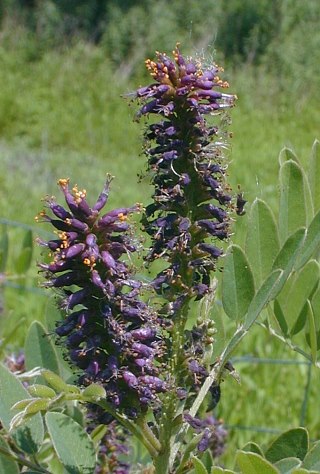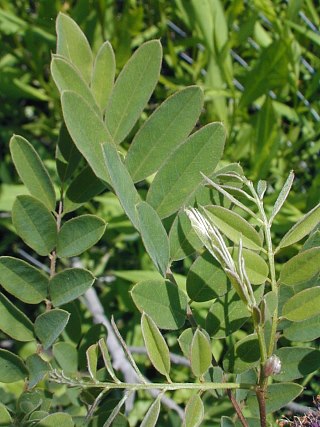Description: This is a shrub about 4-16' tall that branches occasionally. The lower stems are woody; the gray bark is relatively smooth with scattered small lenticels. The upper stems are dull light green and pubescent. The alternate leaves are about ½–1½' long and odd-pinnate with 11-35 leaflets; they have relatively short petioles up to 2" long. Both the petioles and central stalks of the leaves are light gray-green and pubescent. Individual leaflets are 1-2" long and ½–1" across; they are dull gray-green, oblong to broadly oblong, smooth along their margins, and sparsely canescent-pubescent. From the leaflet undersides, scattered translucent glands are visible that resemble small dots. Each leaflet has a tiny pointed tip. The petiolules of the leaflets are slender and short. Occasionally, clusters of 1-6 spike-like racemes of flowers develop from the upper branches. Individual racemes are erect to ascending, 3-8" long, and cylindrical in shape from the dense arrangement of flowers.

Each flower is ¼" long (or a little more) and
tubular in shape from a single violet-purple petal (the standard) that
wraps around the reproductive organs; there is a single style and about
10 stamens that are strongly exerted. The anthers of the stamens are
bright orange-yellow. The blooming period occurs from late spring to
early summer and lasts about 2-3 weeks. The flowers are replaced by
small seedpods about ¼" long (or a little more) that each contain 1-2
seeds. The seedpods are obovoid and somewhat flattened, terminating in
short beaks; their outer surfaces are glandular-punctate. The root
system is woody and branching. Sometimes small colonies of plants
develop at favorable sites.
Cultivation:
The preference is full or partial sun and wet to moist conditions.
False Indigo adapts to different kinds of soil, tolerating occasional
flooding. With the assistance of symbiotic bacteria, it fixes nitrogen
in the ground.
 Range & Habitat:
The native False Indigo is occasional throughout Illinois (see Distribution
Map). Habitats include riverbanks, soggy thickets, open
bottomland woodlands, edges of marshland, and wet prairies along
rivers. It is likely that populations of this shrub have been declining
because of habitat destruction.
Range & Habitat:
The native False Indigo is occasional throughout Illinois (see Distribution
Map). Habitats include riverbanks, soggy thickets, open
bottomland woodlands, edges of marshland, and wet prairies along
rivers. It is likely that populations of this shrub have been declining
because of habitat destruction.
Faunal Associations:
The flowers are pollinated primarily by small to medium-sized bees,
which seek nectar and pollen. These bee visitors include Halictid bees
(Lasioglossum spp.),
masked bees (Hylaeus spp.),
Andrenid bees (Andrena
spp.), little carpenter bees (Ceratina spp.), and
cuckoo bees (Nomada
spp., Coelioxys
spp.). The Andrenid bee, Andrena quintilis,
is a specialist pollinator (oligolege) of Amorpha spp.,
including False Indigo. The caterpillars of Epargyreus clarus
(Silver-spotted Skipper), the butterfly Colias cesonia
(Dogface Sulfur), and the moth Dasylophia anguina
(Black-spotted Prominent) feed on foliage of False Indigo, while
caterpillars of the moth Pleuroprucha insulsaria
(Common Tan Wave) feed on the flowers. Other insects that feed on this
shrub include the lace bug Gargaphia amorphae, the
plant bugs Psallus amorphae and Lopidea
hesperus, and branch-boring larvae of the long-horned beetle Megacyllene
decora. There are also several
leaf beetles that feed on the leaves (Anomoea flavokansiensis,
Anomoea
laticlavia, Odontota
dorsalis, Phyllecthris
dorsalis, and Sumitrosis
rosea). White-tailed Deer browse on this shrub sparingly.
Photographic Location:
Edge of a marsh at Judge Webber Park in Urbana, Illinois.
Comments:
False Indigo looks like a Leadplant (Amorpha canescens)
on steroids. It
is taller than the latter shrub and its leaflets are larger in size. In
southern Illinois and other southern regions, there is some variability
in the size, shape, and hairiness of the leaflets. As a result,
different varieties of False Indigo have been described, but most of
them are rare in Illinois; only the typical variety is occasional
throughout the state. Another shrub with a similar appearance, Amorpha
nitens (Shiny False Indigo), has shiny leaflets that are
hairless (or nearly so). This rare shrub can be found in southern
Illinois, but it is absent from the rest of the state. Other common
names of Amorpha fruticosa are Indigo Bush and
River Locust.